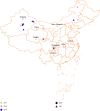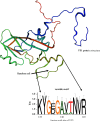Epidemiological and Genetic Analysis of Foot-and-Mouth Disease Virus O/ME-SA/Ind-2001 in China between 2017 and 2021
- PMID: 40303764
- PMCID: PMC12016701
- DOI: 10.1155/2023/3761703
Epidemiological and Genetic Analysis of Foot-and-Mouth Disease Virus O/ME-SA/Ind-2001 in China between 2017 and 2021
Abstract
The O/ME-SA/Ind-2001 lineage of foot-and-mouth disease virus (FMDV) was introduced into China in 2017, which subsequently caused 19 outbreaks of foot-and-mouth disease (FMD) and emerged in 8 provinces in China between 2017 and 2021. It is the first time for WOAH/national reference laboratory for FMD (LVRI) to comprehensively summarize these 19 outbreaks of O/ME-SA/Ind-2001 for consecutive 5 years. Our study selected and conducted whole viral genome sequencing for 9 representative isolates and the VP1 sequences of the FMDV-positive samples collected between 2017 and 2021. Analyses of these gene sequences showed that all the field strains belonged to O/ME-SA/Ind-2001e. Phylogenetic analysis indicated that these viruses were closely related to those circulating in neighboring countries, and there were at least 3 different FMD viral clades (named cluster 1, cluster 2, and cluster 3) circulating during this period. Also, a gradually decreasing nucleotide identity was observed in newly emerging viruses year by year compared with the first isolate identified in 2017. These results suggest extensive movements and constant and rapid evolvement of the O/ME-SA/Ind-2001e sublineage. Besides, the neutralizing antigenic sites in the structural proteins for these O/ME-SA/Ind-2001e viruses were analyzed to predict the vaccine matching between these strains and the commercial vaccine strain O/BY/CHA/2010. The results showed that the VP1 epitope 135-144, highly associated with neutralizing antibody induction, was variable among these strains. The mutations in this region reflected a potential risk of challenging the current vaccine protection. Therefore, there is an urgent need to reinforce the importance of improved FMD surveillance and monitor the evolution of O/ME-SA/Ind-2001e, which will provide essential information for the FMD control program in China and Asia.
Copyright © 2023 Xiangle Zhang et al.
Conflict of interest statement
The authors declare no conflicts of interest concerning this study.
Figures




Similar articles
-
Emergence of an exotic strain of serotype O foot-and-mouth disease virus O/ME-SA/Ind-2001d in South-East Asia in 2015.Transbound Emerg Dis. 2018 Feb;65(1):e104-e112. doi: 10.1111/tbed.12687. Epub 2017 Aug 30. Transbound Emerg Dis. 2018. PMID: 28856846
-
Vaccine strain of O/ME-SA/Ind-2001e of foot-and-mouth disease virus provides high immunogenicity and broad antigenic coverage.Antiviral Res. 2020 Oct;182:104920. doi: 10.1016/j.antiviral.2020.104920. Epub 2020 Aug 20. Antiviral Res. 2020. PMID: 32828822
-
Epidemiological Surveillance and Mutational Pattern Analysis of Foot-and-Mouth Disease Outbreaks in Bangladesh during 2012-2021.Transbound Emerg Dis. 2023 Aug 30;2023:8896572. doi: 10.1155/2023/8896572. eCollection 2023. Transbound Emerg Dis. 2023. PMID: 40303801 Free PMC article.
-
Foot-and-mouth disease status in India during the second decade of the twenty-first century (2011-2020).Vet Res Commun. 2022 Dec;46(4):1011-1022. doi: 10.1007/s11259-022-10010-z. Epub 2022 Oct 3. Vet Res Commun. 2022. PMID: 36190601 Free PMC article. Review.
-
Review of the Global Distribution of Foot-and-Mouth Disease Virus from 2007 to 2014.Transbound Emerg Dis. 2017 Apr;64(2):316-332. doi: 10.1111/tbed.12373. Epub 2015 May 20. Transbound Emerg Dis. 2017. PMID: 25996568 Review.
Cited by
-
MolEpidPred: a novel computational tool for the molecular epidemiology of foot-and-mouth disease virus using VP1 nucleotide sequence data.Brief Funct Genomics. 2025 Jan 15;24:elaf001. doi: 10.1093/bfgp/elaf001. Brief Funct Genomics. 2025. PMID: 40042853 Free PMC article.
-
Knowledge, Attitude and Practices Towards Foot and Mouth Disease Among Farmers and Veterinary Practitioners in Selected Border Regions of Pakistan Adjoining to Afghanistan.Vet Med Sci. 2025 Jul;11(4):e70215. doi: 10.1002/vms3.70215. Vet Med Sci. 2025. PMID: 40622088 Free PMC article.
-
Epidemiology and economics of foot-and-mouth disease: current understanding and knowledge gaps.Vet Res. 2025 Jul 7;56(1):141. doi: 10.1186/s13567-025-01561-5. Vet Res. 2025. PMID: 40624570 Free PMC article. Review.
-
Current trends and challenges in the management of foot and mouth disease in Saudi Arabia: A review.Open Vet J. 2025 May;15(5):1907-1933. doi: 10.5455/OVJ.2025.v15.i5.6. Epub 2025 May 31. Open Vet J. 2025. PMID: 40557100 Free PMC article. Review.
References
MeSH terms
LinkOut - more resources
Full Text Sources

